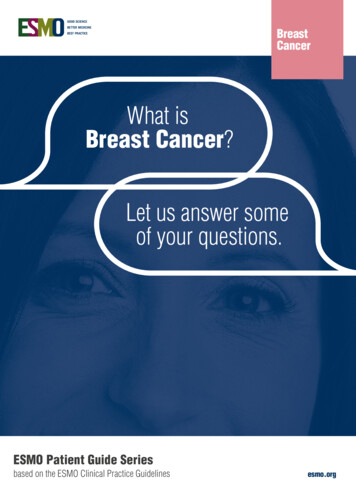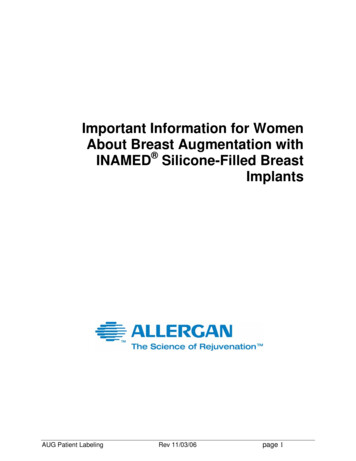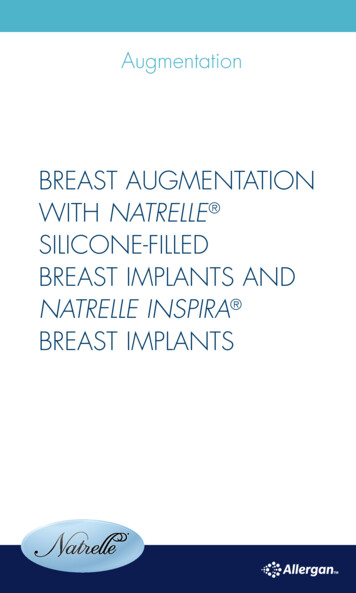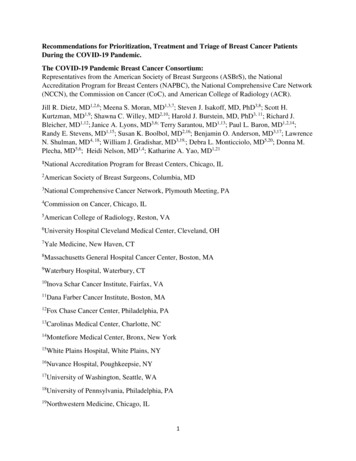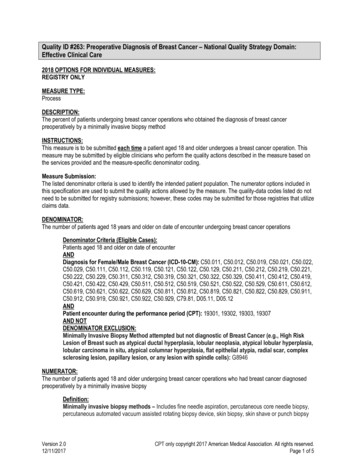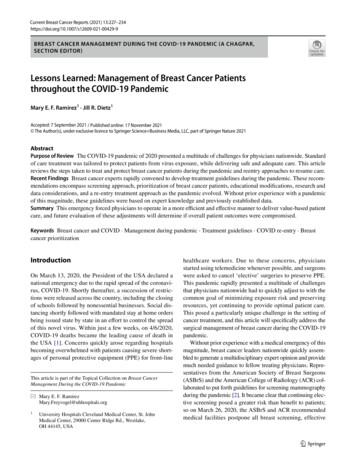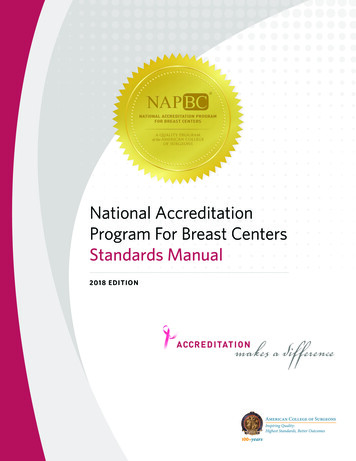
Transcription
National AccreditationProgram For Breast CentersStandards Manual2 01 8 E D ITIO Nmakes a differenceACCREDITATION
Table of ContentsTable of Contents2Disclaimer4Acknowledgements5The NAPBC6–7The Accreditation Process8–11Accreditation Information12Chapter 1: Center Leadership13–22Standard 1.1: Level of Responsibility and Accountability14–17Standard 1.2: Multidisciplinary Breast Care Conference18–20Standard 1.3: Evaluation and Management Guidelines21Chapter 2: Clinical Services23–60Standard 2.1: Multidisciplinary Patient Management24Standard 2.2: Patient Navigation25–26Standard 2.3: Breast Conservation27–28Standard 2.4: Sentinel Node Biopsy29–30Standard 2.5: Breast Cancer Surveillance31Standard 2.6: Breast Cancer Staging32–33Standard 2.7: Pathology34–35Standard 2.8: Breast Imaging36–37Standard 2.9: Needle Biopsy38Standard 2.10: Ultrasonography39–40Standard 2.11: Stereotactic Core Needle Biopsy41Standard 2.12: Radiation Oncology42–44Standard 2.13: Medical Oncology45–46Standard 2.14: Nursing47Standard 2.15: Support and Rehabilitation48–49Standard 2.16: Genetic Evaluation and Management50–52Standard 2.17: Educational Resources53Standard 2.18: Reconstructive Surgery54–55 2017 American College of Surgeons 633 N. Saint Clair St. Chicago, IL 60611-3211 All rights reserved.
Table o f Co n tents56–57Standard 2.20: Breast Cancer Survivorship Care58–60Chapter 3: Research61–64Standard 3.1: Clinical Trial Information62Standard 3.2: Clinical Trial Accrual63–64Chapter 4: Community Outreach65–68Standard 4.1: Education, Prevention, and Early Detection Programs66–67Chapter 5: Professional Education69–72Standard 5.1: Breast Care Team Continuing Education70–72Chapter 6: Quality Improvement73–76Standard 6.1: Quality and Outcomes74–76Glossary77–79Table of ContentsStandard 2.19: Evaluation and Management of Non-Malignant Breast Disease
DisclaimerDisclaimerThe National Accreditation Program for Breast Centers Standards Manual is intended as aninstructive tool to assist health care providers and institutions in improving the care of patientswith breast disease. It is not intended to replace the professional judgment of the physician,health care provider, or health care administrator in individual circumstances. The AmericanCollege of Surgeons and the National Accreditation Program for Breast Centers cannot accept,and expressly disclaim, liability for claims arising from the use of this work.4ACC RE DI TAT ION MAKES A DIFFERENCE
AcknowledgmentsACKNOWLEDGMENTOF CONTRIBUTORSThe National Accreditation Program for Breast Centers (NAPBC) isthankful to its Board for its efforts to improve the care and treatment ofbreast cancer patients both in the United States and internationally.Specifically, the NAPBC acknowledges the many contributionsof the members of the Standards and AccreditationCommittee who were vital to the creation of the 2018 NationalAccreditation Program for Breast Centers Standards Manual.STANDARDS ANDACCREDITATION COMMITTEESTAFFCONTRIBUTORS Steffanye Hawbaker Mack Barbara Rabinowitz, PhD, Vice-Chair Ashley Logan Paul Baron, MD, FACS Karen Pollitt Cynthia Boudreaux, LPN, CTR Karen Taubert-Boone Anees Chagpar, MD, FACS, FRCS(C) David Winchester, MD, FACSAcknowledgments Terry Sarantou, MD, FACS, Chair James Connolly, MD, FCAP Jill Dietz, MD, FACS Jessica Everett, MS, CGC Erica Fischer-Cartlidge,MSN, CNS, CBCN, AOCNS Teresa Heckel, MBA Scott H. Kurtzman, MD, FACS Alison Laidley, MD, FACS Claudia Lee, MBA Ruth O’Regan, MD Robert Rosenberg, MD Dana Smetherman, MD, MPH, FACR Scott Weissman, MSN A P B C STA N DA R DS M A N UA L 201 8 E D IT I O N5
The National Accreditation Programfor Breast Centers (NAPBC)NAPBC MISSIONSTATEMENTThe National Accreditation Program for Breast Centers (NAPBC)is a consortium of national, professional organizations focusedon breast health and dedicated to the improvement of qualityoutcomes of patients with diseases of the breast through evidencebased standards and patient and professional education.NAPBC BACKGROUND AND THE VALUE OF ACCREDITATIONThe evaluation and management of patients with diseases of the breast historically occurred in afragmented, disorganized setting. In this complex environment patients are best managed throughmultidisciplinary coordination. This team approach resulted in the birth of the breast center concept inthe United States in the 1970s. In the past three to four decades there has been a proliferation of breastcenters to accommodate the thousands of women diagnosed with breast cancer, as well as addressingthe equally compelling needs of the many women presenting with non-malignant breast diseases.Evidence-based and consensus-developed standards have gained increasing importance and recognition.The United States health care system is undergoing a dramatic transformation centered on qualitymeasurement and improvement and documentation of adherence to broadly accepted standards of care forall diseases including those of the breast. No other organization has established standards for the evaluationand management of patients with diseases of the breast or a survey process to monitor compliance. In order toimprove the quality of evaluation and management of patients, the NAPBC accredits established breast centers.It recognizes that, in the United States, breast care is delivered in heterogeneous settings. The accreditationprogram is designed to be inclusive. Accreditation is awarded to academic medical centers, teachinghospitals, hospitals, freestanding centers, and private practices provided the NAPBC standards are met.NAPBC-accredited centers demonstrate the following services:The NAPBC A multidisciplinary team approach to coordinate the best careand treatment options available Access to breast-specific information, education, and support Breast center data collection on quality indicators for subspecialties involvedin breast cancer diagnosis and treatment Ongoing monitoring and improvement of care Information about participation in clinical trials and new treatment options6ACC RE DI TAT ION MAKES A DIFFERENCE
Th e NA PBCNAPBC BOARD MEMBER ORGANIZATIONS American Cancer Society American College of Radiology Commission on Breast Imaging American College of Radiology Imaging Network American College of Surgeons American Institute of Radiologic Pathology American Society of Breast Surgeons American Society of Clinical Oncology American Society of Plastic Surgeons American Society for Radiation Oncology Association of Cancer Executives Association of Oncology Social Work College of American Pathologists National Cancer Registrars Association National Consortium of Breast Centers National Society of Genetic Counselors Oncology Nursing Society Society of Breast Imaging Society of Surgical OncologyThe NAPBCBENEFITS OF BECOMING AN NAPBC-ACCREDITED CENTERAccreditation by the NAPBC provides many notable benefits that will enhance a breast centerand its quality of patient care.NAPBC-accredited breast centers receive the following: A model for organizing and managing a breast center to ensure multidisciplinary, integrated,and comprehensive breast care services Internal and external assessment of breast center performance based on recognized standardsto demonstrate a commitment to quality care Recognition as having met performance measures for high-quality breast care establishedby national health care organizations National recognition and public promotion Participation in a National Breast Disease Database to report patterns of careand effect quality improvement (in development) Access to breast center comparison benchmark reports containing national aggregate dataand individual center data to assess patterns of care and outcomes relative to national norms(in development)N A P B C STA N DA R DS M A N UA L 201 8 E D IT I O N7
The Accreditation ProcessACCREDITATIONCYCLEThe initial site visit date establishes the accreditationcycle. After initial accreditation, the re-accreditationsite visit occurs once every three (3) years.THE ANNUAL ACCREDITATION FEEFor centers seeking initial accreditation with the NAPBC, an invoice will be issued to the breast centerfor the annual accreditation fee, after approval of the initial accreditation application.For re-accrediting centers, an invoice for the annual NAPBC accreditation fee is e-mailed to the breast centerbilling contact each year, approximately sixty (60) days prior to the center’s accreditation due month.Payment of the annual accreditation fee is due within thirty (30) days of the date of the invoice.Failure to pay the annual accreditation fee may result in suspension of accreditation.ACCREDITATION RESOURCES FOR CENTERSA full list of accreditation resources is available on the NAPBC webpage, napbc-breast.org.INITIAL ACCREDITATIONAll centers seeking accreditation for the first time must submit an application through the NAPBCCenter Portal. Within thirty (30) days of submission of the application, or as soon as practical thereafter,the primary contact listed will be notified of approval or if additional information is required.After approval of the application and completion of all required agreements, the breastcenter must complete the Center Profile in the NAPBC Center Portal.One component of determining whether NAPBC accreditation will be awarded to a breast centeris the site visit. The initial NAPBC site visit occurs after the applying center attests that the NAPBCstandards have been in place and complied with in the center for twelve (12) months.In preparation for accreditation, the center must:1. Assess and demonstrate compliance with the requirements for all standards outlinedin National Accreditation Program for Breast Centers Standards Manual2. Submit payment for the annual accreditation fee3. Confirm the site visit date with the assigned surveyor4. Complete and upload required documentation to the Survey Application Record (SAR)Centers are notified of their assigned NAPBC surveyors by e-mail.The Accreditation ProcessNote: the site visit does not count as one of the required Breast Program Leadership Committee (BPLC) meetings.REQUIRED DOCUMENTATIONAll documentation demonstrating compliance with the NAPBC standards, excluding patient medical records,must be uploaded and completed in the SAR.8ACC RE DI TAT ION MAKES A DIFFERENCE
Th e Acc redit at io n Pro cessTHE SITE VISITIn preparation for the site visit, the SAR must be submitted no later than thirty (30) calendar daysbefore the site visit.The surveyor’s role is to verify whether the breast center is in compliance with the NAPBC standards.On the day of the site visit, the surveyor will: Present information to key members of the center’s leadership on the NAPBC Meet with the BPLC to discuss the activities and responsibilities of its members and to verifythe accuracy of the data and documentation submitted Attend a Breast Conference to observe the center’s multidisciplinary patient managementand discussions Meet with the Breast Program Director to discuss the Director’s roles and responsibilities Conduct a medical records review as outlined in the standards Tour the center Conduct a summation to provide initial impressions on the breast center’s strengths,areas in need of improvement, and provide a chance for the Breast Care Team (BCT)and BPLC members to ask and respond to any additional questionsIt is recommended that all members of the BPLC attend and participate in the site visit.At a minimum, the surveyor must meet with the following people: Administrators with fiduciary and administrative oversight of the center Key clinician leaders Breast Program DirectorMEDICAL RECORDS REVIEWMany NAPBC standards require a medical records review to ensure compliance with rating criteria.Compliance with these components of the rating criteria will be evaluated during the site visit, throughthe surveyor’s medical records review of 20 patient medical records from the provided accession list.The percentage of medical records that meet the rating criteria will determine whether the breastcenter is in compliance with that aspect of the standard.The breast center will provide the surveyor with an accession list of eligible cancer patients forthe medical records review. No later than fourteen (14) calendar days before the site visit, thesurveyor will inform the center of the selected, applicable medical records that will be reviewed.The Accreditation ProcessIn addition, the breast center will make available five (5) medical records, of their selection,of patients with non-malignant breast disorders, and five (5) additional medical records,of their selection, of patients with high risk lesions.The medical records reviewed are not required to be deidentified. Review of the patient healthinformation (PHI) is covered by the Business Associate Agreement (BAA) that the center signsat the time of application for accreditation.N A P B C STA N DA R DS M A N UA L 201 8 E D IT I O N9
The Acc re di t at i o n Pro ce ssTHE POST-SURVEY EVALUATIONThe Post-Survey Evaluation (PSE) is a required component of the NAPBC site visit.The PSE captures feedback from the breast center, which enables the NAPBC to evaluateand improve the site visit process. Feedback from the PSE also assists development ofeducational materials and training programs for both surveyors and participating centers.All PSE responses are confidential and do not influence the NAPBC site visit results. Only one PSE iscollected per center, therefore, responses on the evaluation form must represent a consensus opinionof the BPLC. The PSE must be completed within fourteen (14) calendars days of the site visit.NOTIFICATION OF SITE VISIT RESULTSA performance report, detailing the results of the breast center’s site visit, will be available within forty-five (45)days of the site visit date, or as soon as practical thereafter. The Breast Program Director will receivean e-mail when the completed performance report is available.The performance report provides the following: A summary of the site visit outcome and accreditation award The breast center’s rating for each standard A narrative description for noncompliant standards Suggestions to improve or enhance the breast centerAPPEALSCenters may appeal a finding for any standard within forty-five (45) calendar days of the performance reportnotification. The appeals process is outlined in the Accreditation Decision Appeal Form on the NAPBC website.DEFICIENCY RESOLUTIONA breast center that received one (1) to eight (8) deficiencies is required to complete the deficiency resolutionprocess. The deficiency resolution process begins on the site visit date and ends twelve (12) months afterthe site visit date. A program that fails to resolve deficiencies within the allotted time are at risk ofhaving accreditation withdrawn.CERTIFICATES, MARKETING, AND VISIBILITYCenters that are awarded Three Year Full accreditation and Three Year accreditation with deficiency, can orderone (1) complimentary Certificate of Accreditation. Additional copies are available for purchase. Certificateinformation is on the marketing resources webpage. The link is provided in the performance report cover letter.The Accreditation ProcessIn addition to displaying the Certificate of Accreditation, the NAPBC encourages breast centers to use themarketing tools provided on the marketing resources webpage, to promote the value of NAPBC accreditationto patients, families, and the community. The marketing tools include an NAPBC-accredited center logo,patient brochures, event posters (for example, Breast Cancer Awareness), and more. A link to the marketingresources webpage will be provided to the breast center in the performance report cover letter,if the center achieves full accreditation.Centers that are awarded full accreditation are listed on the NAPBC-accredited center locator.The locator is an online search engine for patients to find an accredited center. Listings on the locatorinclude the center name, location, website, description, and an image of the breast center. Breast centerprofiles can be edited in the General Center Information section of the NAPBC Center Portal.10ACC RE DI TAT ION MAKES A DIFFERENCE
Th e Acc redit at io n Pro cessSITE VISIT POSTPONEMENT AND CANCELLATIONSWhen extenuating circumstances affect center activity, a site visit postponement may be appropriate.Postponements are granted on a case-by-case basis, with a maximum postponement being six (6) months.Valid extenuating circumstances that may warrant a site visit postponement include,but are not limited to: Natural disasters (for example, hurricane, earthquake, tornado, flood)that directly affect the center Anthropogenic hazards (for example, fire, industrial accidents)that directly affect the centerExamples of circumstances that do not warrant a site visit postponement include,but are not limited to: Software conversion or IT issues Staff absences, turnovers, or resignations Delayed abstracting or missing data Standard deficienciesThe Breast Program Director must submit a formal request for a postponement via e-mail toNAPBC@facs.org. The request must include specifics regarding the rationale for the request, a proposedplan, and a timeline to resolve the issues necessitating the postponement request. The center will be notifiedof the postponement request decision as soon as practical, following receipt of the written request.Centers are discouraged from canceling the scheduled site visit. However, if site visit cancellation becomesnecessary after the site visit date is confirmed, the breast center must submit a written notification toNAPBC@facs.org. The center will be invoiced for a cancellation fee and any non-refundable travelexpenses incurred by the surveyor.The Accreditation ProcessN A P B C STA N DA R DS M A N UA L 201 8 E D IT I O N11
Accreditation InformatiuonAccre d i t at i o n I n fo r m at i o nAccreditation InformationRatings for each standard are assigned based on a consensus by the NAPBC Surveyorand an NAPBC Technical Reviewer. When required, the applicable review subcommitteewill also contribute to the standard rating decision, as a final adjudicator.CRITICAL STANDARDSThree (3) standards are considered critical standards. The breast center must be in compliance withthe following standards at the time of the site visit in order to receive NAPBC Accreditation: Standard 1.1: Level of Responsibility and Accountability Standard 1.2: Multidisciplinary Breast Cancer Conference Standard 2.1: Multidisciplinary Patient ManagementACCREDITATION AWARDS AND RATING SYSTEMBased on the rating criteria specified for each standard a “Compliant,” or “Noncompliant,” rating is assigned.Any standard with a “Noncompliant” rating is a “deficiency.”Accreditation awards are determined by the number of noncompliant ratings the breast center receives.Following the site visit, a center receives one of the three Accreditation Awards.Three Year Accreditation is conferred to a center that receives a “Compliant” rating for all standards atthe time of the site visit. A certificate of accreditation is issued.Three Year Accreditation with Deficiency is conferred to a center when one (1) to three (3) of the standardsare rated “Noncompliant” at the time of the site visit. Deficiency resolution documentation must be submittedwithin 12 months of the date of the site visit. A certificate of accreditation is issued.Three Year Contingency Accreditation is conferred to a center when four (4) to eight (8) standards are rated“Noncompliant” at the time of the site visit. Deficiency resolution documentation must be submitted withintwelve (12) months of the date of the site visit. A center that does not resolve its deficiencies within the allottedtimeframe is at risk of having its accreditation status discontinued. A certificate of accreditation is only issuedafter resolution of all deficiencies.The Accreditation ProcessAccreditation Deferred is conferred to a center when one (1) or more of the critical standards is rated“Noncompliant.” Accreditation Deferred is also conferred to a center that receives a “Noncompliant” ratingfor nine (9) or more standards. When applicable, NAPBC staff will work directly with the center to assistwith deficiency resolution, so accreditation may be reinstated. The deferred status is resolved by submissionof documentation for compliance and/or an additional site visit within twelve (12) months. Centers can alsochoose to withdraw, improve their performance, and then reapply for accreditation as a new center. Note,new center application fees will apply when reapplying for accreditation.12ACC RE DI TAT ION MAKES A DIFFERENCE
Chapter One:Center LeadershipN A P B C STA N DA R DS M A N UA L 201 8 E D IT I O N13
Chapter One—Center Leadership1 .1Level of Responsibility and AccountabilitySTANDARD 1.1The organizational structure of the breast center gives the Breast ProgramDirector (BPD) and Breast Program Leadership Committee (BPLC) responsibilityand accountability for provided services.DEFINITION AND REQUIREMENTSBreast Program DirectorThere must be a single Breast Program Director with authority and accountability for the operation of thebreast center.Breast Program Leadership CommitteeThe Breast Program Leadership Committee (BPLC) is the governing body of the breast center and is chaired bythe BPD. There must be a core group of health care professionals from different disciplines who contribute tothe policies and procedures of the center. BPLC member disciplines include, but are not limited to, pathology,radiology, surgery, medical oncology, radiation oncology, reconstruction, research, nursing, social work,hospital administration, and other members when probable and as deemed necessary by the BPD.To ensure all decisions of the BPLC include the voice of the patients we serve, it is recommended thata community representative and/or patient representative be a full member of the BPLC.Requirements for BPLC membership: The physician committee members have current specialty board certification in their areaof specialty or be in the process of obtaining board certification as applicable The physician committee members possess current medical licensure and appropriateactive medical staff appointment The non-physician committee members have appropriate qualifications/certificationsin their field and hold appropriate breast program relationships and accountability as outlinedin the applicable standards The committee members establish and maintain an environment of professional developmentand scholarship The committee members regularly participate in organized clinical discussions, journal clubs,and conferencesThe BPD and the BPLC are responsible for goal setting, as well as planning, initiating, implementing,evaluating, and improving all breast-related activities in the center.Breast Care TeamThe breast center must have a designated Breast Care Team (BCT). The BCT includes health careprofessionals who contribute to the active assessment, treatment, and/or dissemination of informationto a breast center patient, including pathologists, radiologists, surgeons, medical oncologists, radiationoncologists, cancer registrars, physician assistants, radiology technologists, registered nurses, licensedpractical nurses, nurse practitioners, genetic counselors, patient navigators, social workers, and othermembers deemed necessary by the BPLC.14ACC RE DI TAT ION MAKES A DIFFERENCE
Chapter One—Center Leadership1.1Requirements for BCT membership: Have appropriate qualifications/certifications/registrations in their field Collaborate and develop a treatment plan that will lead to the best possible quality outcomefor the breast disease patient Provide patient care in accordance with institutional policies and in compliancewith National Accreditation Program for Breast Centers (NAPBC) Standards Attend the multidisciplinary conference as appropriate Participate in annual continuing education sessions in compliance with NAPBC requirementsAll professionally credentialed members of the BCT must have appropriate certification.All physician team members are required to be board certified or in the process of obtaining board certification.Other Program PersonnelThe program must ensure the availability of all necessary administrative personnel for the effectiveadministration of the program. Some examples include, but are not limited to: Chief executive office/dean Center/hospital administration Marketing director Administrative assistants Data analystsPROCESS REQUIREMENTSBreast center or medical staff office process requirements:The breast center or medical staff formally establishes the responsibility, accountability, and multidisciplinarymembership required for the BPLC to fulfill its role.The center documents the BPD’s and the BPLC’s responsibility and accountability using a method appropriateto the center’s organizational structure.Examples include, but are not limited to: The center bylaws designate the BPLC as a subcommittee of the cancer committeewithin a larger institution with authority defined The medical staff bylaws designate the BPLC to be a standing committee with authority defined Policies and procedures for the center define authority of the BPD and the BPLC Policies and procedures for the medical staff define the authority of the BPD and the BPLCThe breast center must have a defined multidisciplinary Breast Care Team with a minimum of one appointedphysician member from each of the following specialties: surgery, pathology, radiology, medical oncology,and radiation oncology.N A P B C STA N DA R DS M A N UA L 201 8 E D IT I O N15
Chapter One—Center Leadership1 .1BPD process requirements: Be familiar with and comply with NAPBC site visit policies and proceduresas outlined in the NAPBC Standards Manual Designate an individual to prepare and submit all information required and requestedby the NAPBC (including program changes/requests), and ensure that the informationsubmitted is accurate and complete. This information includes, but is not limited to: Program application forms Annual program updates Center name updates/changes Satellite site information Change of Breast Program Director Voluntary withdrawal Deficiency resolution Appeals Oversee and monitor compliance with the NAPBC Standards, including all participating satellite centers Ensure the medical staff bylaws, policies, and regulations designate and define the BPLC authorityand reporting accountability Approve the selection of BCT members as appropriate, and confirm that all professionallycredentialed members of the BCT have specialty certification Define the policies and procedures for the BCT and other breast program personnel Distribute policies and procedures to the BPLC and BCTBPLC process requirements: Meet a minimum of four times per year In conjunction with the BPD, plan, develop, implement,and evaluate all activities of the breast center Oversee and monitor compliance with the NAPBC Standards,including all participating satellite centers Review all center data annually16ACC RE DI TAT ION MAKES A DIFFERENCE
Chapter One—Center Leadership1.1DOCUMENTATIONComplete all required standard fields in the Survey Application Record (SAR).Upload/describe the organizational structure of the breast center.Complete and upload the Breast Care Team Worksheet.Upload BPLC meeting minutes for the last three years.Upload bylaws or policy and procedures, or other center-approved methods, used to document the levelof responsibility and accountability designated to the BPD.Complete and upload the BPLC annual audit template.E VALUATIONThe surveyor will discuss the organizational structure of the center and review and discussall required documentation during the site visitRATING COMPLIANCECompliance:1. The organizational structure of the breast center gives the BPD and BPLC responsibilityand accountability for provided breast center services.Noncompliance: The center does not fulfill one or more of the compliance criteria.RESOURCESNAPBC Accreditation Resources, urcesN A P B C STA N DA R DS M A N UA L 201 8 E D IT I O N17
Chapter One—Center Leadership1.2Multidisciplinary Breast Care ConferenceSTANDARD 1. 2The Breast Program Leadership Committee (BPLC) establishes, monitors, andevaluates the multidisciplinary breast care conference (MBCC) frequency,Breast Care Team (BCT) attendance, prospective and total annual casepresentation, including American Joint Committee on Cancer (AJCC) staging,and discussion of nationally accepted guidelines.DEFINITION AND REQUIREMENTSBreast care conferences are integral to improving the care of breast disease patients by contributing to patientmanagement and outcomes while providing education to physicians and other staff in attendance.Input should be encouraged from all BCT members.The breast center must ensure the multidisciplinary breast care conferences are scheduled to permit attendanceon a regular basis. Conferences must include prospective multidisciplinary case evaluation by the BCT.This comprehensive approach allows the BCT to:1. Promote inclusion of a broad range of physician and other specialists to address early diagnosis,quality of life, ethics, or other relevant topics2. Improve patient care, promote effective management of resources, and make decisionswhich reflect the patient's goals for treatment3. Discuss treatment options, including investigational therapy, for breast cancer patientsto offer a collaborative recommendationMonitoring of breast cancer conference activity by the BPLC, including multidisciplinary representation andindividual attendance, ensures that conferences provide consultati
National Consortium of Breast Centers National Society of Genetic Counselors Oncology Nursing Society Society of Breast Imaging Society of Surgical Oncology BENEFITS OF BECOMING AN NAPBC-ACCREDITED CENTER Accreditation by the NAPBC provides many notable benefits that will enhance a breast center and its quality of patient .
